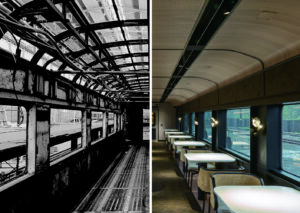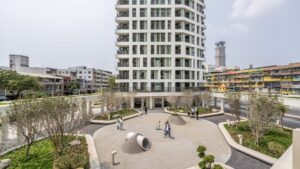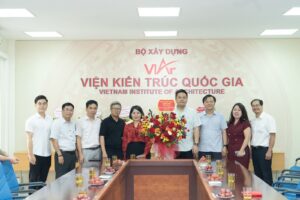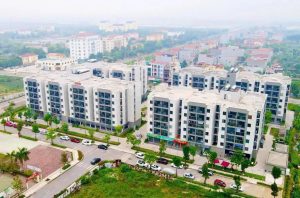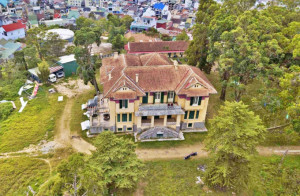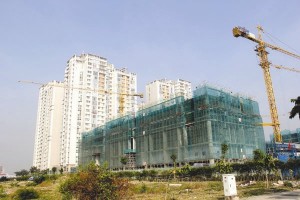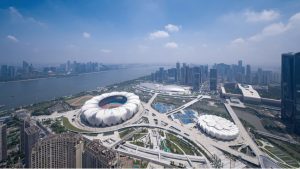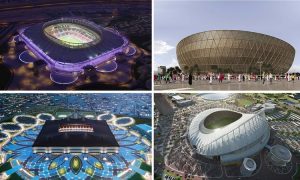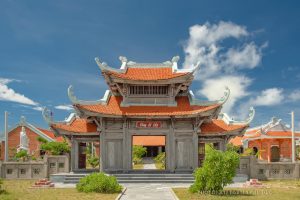Công bố quốc tế trong lĩnh vực kiến trúc, xây dựng (Tuần 1 tháng 7-2021)
Trong số này chúng tôi xin giới thiệu tới quý độc giả những nội dung chính của các công bố quốc tế đăng tải trên ScienceDirect và Springer Nature do Cục Thông tin khoa học và công nghệ quốc gia (NASATI) mua quyền truy cập như sau:
Quy hoạch đô thị:
– Mô phỏng máy tính thiết kế cảnh quan sân vườn đô thị dựa trên FPGA và mạng nơron
– Mô hình hóa chất ô nhiễm và quy hoạch đô thị: cách tiếp cận liên ngành để lập mô hình thành phố
– Xác định các chỉ số bền vững chính trong hệ thống đô thị Tây Ban Nha
– Một số mô hình cảnh quan bền vững
– So sánh hai mô hình đô thị dựa trên học sâu
– Phương pháp tiếp cận mới để đo lường và hình dung khả năng tiếp cận đô thị
– Tầm nhìn về cải cách xây dựng đô thị trong tương lai của Trung Quốc dưới góc độ phòng ngừa và kiểm soát toàn diện đối với thảm họa
– Thiết kế cảnh quan thành phố thông minh dựa trên cảm biến không dây
– Tác động của bóng cây và công trình lên đảo nhiệt đô thị: kết hợp viễn thám, thành phố kỹ thuật số 3D và phương pháp hồi quy không gian
Khoa học và công nghệ trong lĩnh vực kiến trúc, xây dựng:
– Khung công nghệ chuỗi khối và kép kỹ thuật số tích hợp hỗ trợ chia sẻ dữa liệu trong các dự án xây dựng
– Khung thông số kỹ thuật của máy in bê tông 3D
– Nền tảng mã nguồn mở có thể mở rộng cho hệ thống quản lý tài sản cơ sở hạ tầng chung
– Tối ưu hóa can thiệp đa hệ thống đối với cơ sở hạ tầng phụ thuộc lẫn nhau
– Giám sát tiến độ xây dựng nội thất dựa trên thị giác máy tính
– Mô hình xác định ứng xử cầu treo dây võng trong quá trình xây dựng
– Hướng tới tài liệu kỹ thuật số tự động và báo cáo tiến độ của các đường ống xây dựng cơ khí bằng điện thoại thông minh
– Phân tích quyết định đa tiêu chí để lập kế hoạch bố trí cần trục tháp trong xây dựng tích hợp mô-đun cao tầng
– Sự khác biệt giữa các vùng và hiệu quả sử dụng đất xanh đô thị ở Đồng bằng sông Dương Tử, Trung Quốc
Vật liệu xây dựng:
– Phương pháp sản xuất glulam không sử dụng khuôn với sự hỗ trợ của công nghệ thị giác máy tính
– Quy trình tiêu chuẩn hóa tro bã mía để sản xuất bê tông khối lượng lớn
– Phân tích thống kê các khuyết tật bên trong bê tông dưới nhiệt độ cao dựa trên ảnh SEM
– Xây dựng khuôn khổ để lựa chọn tro bã mía tốt nhất từ các nguồn khác nhau sử dụng trong sản xuất xi măng
– Ảnh hưởng của cốt liệu, cốt sợi thủy tinh và cốt liệu tái chế đến vữa polyester
– Phát triển bùn đá cẩm thạch làm vật liệu kết dính bổ sung thông qua quá trình nung
– Triển vọng sử dụng bột vỏ trứng trong vật liệu xây dựng bền vững
– Ảnh hưởng của các kết nối bắt vít đến hoạt động của khung gỗ dưới tải trọng dọc và ngang kết hợp
– Đánh giá vật liệu vá hiệu quả cho mặt cầu bê tông
Xin trân trọng giới thiệu!
QUY HOẠCH ĐÔ THỊ
1. Computer simulation of urban garden landscape design based on FPGA and neural network
Microprocessors and Microsystems, Volume 83, June 2021, 103988
Abstract:
Digital Landscape is a combination of the system and the computer software and hardware system of a high simulation model. The author analyzes the application of computer simulation in landscape design and value analysis of a city garden. In the computer-aided design, the importance of digitizing information in the landscape design process, mainly human and the interaction of computer, is reflected in the digital model’s creation and multimedia performance, becoming more and more evident. To form a two-dimensional or three-dimensional spatial data, to realize real-time, statistical Analysis, using the human living environment, multi-dimensional, efficient, and humane, and environmental landscape plan to more rational and practical, used the computer simulation techniques. Effective use of urban rainwater, to reduce the flooding of urban areas, it is possible to alleviate the water crisis, the organic combination of rainwater can be used in the course of the construction of the urban landscape as well as make-up landscape, visual beautification has optimized the ecosystem, and from many rainwater utilization functions; These functions in landscape design, rainwater garden, It can be realized the rooftop garden, and the city’s green. The construction and sustainable economy and the promotion of the ecological park’s social development will positively sign. Suitable for rainwater regulation, water (recovery) is stored—Computer-Aided Design (CAD) green space. Technical measures save of suggestions for practical application of the square: innovation and new of space design, new artificial wetland system, and garden rainwater in the application of the regulation (population) storage system design of the water-saving of these to the sustainable development of such new square of rainwater adjustment (group) storage system design and urban landscape environment. It is useful for the application of technology.
2. Atmospheric dispersion and urban planning: An interdisciplinary approach to city modeling
Sustainable Cities and Society, Volume 70, July 2021, 102882
Abstract:
Geometry modeling is a common approach in pollutant dispersion studies. Block typology is a key element for representing geometries closer to real city environments. However, urban pollutant modeling studies and urban planning processes have different approaches regarding block typology and applied metrics. Therefore, the objective of this work is to compare urban block typologies and urban metrics used in literature studies with those found in real cities. The methodology combined a literature review with an empirical analysis of sample areas in selected cities. The results showed that more than 50 % of the studies applied idealized building arrays. Nonetheless, the idealized array tends to underestimate real densities, often misrepresenting urban planning indices. On the other hand, derived geometry reduces modeling complexity and increases the applicability of studies in urban planning. Based on our findings, we suggest an urban block parameterization derived from real urban areas (representative of the densest cities in Asia, Europe, and America). This study selects five block typologies derived from actual cities (single block, detached buildings, courtyard, inner courtyards, and row buildings) with estimated values of the floor area ratio (FAR) and surface coverage (SC) that, when combined, provide a more precise representation of density.
3. Defining a procedure to identify key sustainability indicators in Spanish urban systems: Development and application
Sustainable Cities and Society, Volume 70, July 2021, 102919
Abstract:
Urban population has exponentially growth in the last decades and as consequence, cities concentrate part of global environmental burdens among other impacts. Therefore, the use of indicators to evaluate the cities in order to achieve their better and more sustainable future was receiving special attention in the last years. Accordingly, the considered indicators would reflect the traditional three pillars of sustainability: social, economic and environmental. In the present study, Classification And Regression Trees (CART) and Random Forest, were applied over a case study in which the sustainability of 31 Spanish cities was evaluated considering 38 indicators. The main goals were to identify the key indicators and to quantify the corresponding thresholds to define a sustainable city. The key indicators identified were: “woman unemployed rate”, “city unemployment rate” and “Municipal Solid Waste collected” and the corresponding thresholds are 14 %, 16 % and 423 kg inhabitant-1 year-1 respectively. In addition, the sustainability of 32 different Spanish cities was evaluated with these three indicators and thresholds to validate the achievements. According with the results, urban sustainability could be evaluated considering only three indicators with a high degree of accuracy, providing information to policy makers without the requirement of compiling a large amount of data.
4. Promoting sustainable landscape pattern for landscape sustainability
Landscape Ecology volume 36, pages1839–1844 (2021)
Abstract:
As a consequence of the global scientific interest in sustainable development, sustainable landscape patterns have been proposed following the research paradigm “spatial pattern—ecosystem processes/functions-ecosystem services-human well-being” and become a frontier research topic in the intersection of landscape ecology and landscape sustainability science (Cumming et al. 2017; Wu 2013). Sustainable landscape patterns describe a typology of landscape that provides the ecological benefits required to meet the economic, social and ecological demands of both present and future generations (Wu 2013). This novel concept is supported by the scientific community studying landscape ecology and sustainability science, and forms a tangible target for ecosystem-based management approaches (Musacchio 2013; Peng et al. 2018b). There are several typical sustainable landscape patterns which could be distinguished depending on the various environmental protection targets and regional development needs. For example, ‘urban growth boundary’ (UGB) ensures the protection of sustainable ecosystems in the context of rapid urbanization characterized by intensified habitat fragmentation (Huang et al. 2019). Whereas, ‘ecological network’ (EN), a concept rooted in landscape connectivity, provides an operational approach for conserving biodiversity (Hofman et al. 2018), and ‘green infrastructure’ (GI) shows a vision of a cost-effective, nature-based solution for ecosystem maintenance as well as social development (Matthews et al. 2015). Finally, ‘ecological security pattern’ (ESP) provides an integrated focus on individual or coupled landscape elements which can protect and enhance regional ecosystem structures, functions and services (Peng et al. 2019).
Sustainable landscape patterns emphasize the coupling of spatial patterns, social-ecological processes and ecosystem services across multiple disciplines, including landscape ecology, urban planning and landscape design. Hence, identifying and preserving sustainable landscape patterns will not only provide basic regional protection for critical ecosystem services and a healthy living environment, but can also be seen as an effective measure to control in a sustainable way the threats imposed by anthropogenic activities (Peng et al. 2018a). Consequently, planning, designing and constructing sustainable landscape patterns to effectively preserve regional ecological stability and security is an important way to maintain regional sustainable development. This special issue is a collection of innovative contributions focusing on sustainable landscape patterns, including but not limited to landscape sustainability science, UGB, EN, GI and ESP.
5. Bundling ecosystem services at a high resolution in the UK: trade-offs and synergies in urban landscapes
Landscape Ecology volume 36, pages1817–1835 (2021)
Abstract:
Ecosystem service bundles can be defined as the spatial co-occurrence of ecosystem services in a landscape. The understanding of the delivery of multiple ecosystem services as bundles in urban areas is limited. This study modelled ecosystem services in an urban area comprising the towns of Milton Keynes, Bedford and Luton.
The objectives of this study were to assess (1) how ecosystem service bundles scale at a 2 m spatial resolution and (2) identify and analyse the composition of ecosystem service bundles.
Six ecosystem services were modelled with the InVEST framework at a 2 m resolution. The correlations between ecosystem services were calculated using the Spearman rank correlation coefficient method. Principal Component Analysis and K-means cluster analysis were used to analyse the distributions, spatial trade-offs and synergies of multiple ecosystem services.
The results showed that regulating services had the tendency to form trade-offs and synergies. There was a significant tendency for trade-offs between supporting service Habitat quality and Pollinator abundance. Four bundle types were identified which showed specialised areas with prevalent soil erosion with high levels in water supply, areas with high values in nutrient retention, areas with high levels in carbon storage and urban areas with pollinator abundance.
services and the formation of ecosystem service bundles in urban areas. This study provides a better understanding of the interactions between services and improve the management choices in ecosystem service provision in urban and landscape planning.
6. A multistep approach to improving connectivity and co-use of spatial ecological networks in cities
Landscape Ecology volume 36, pages2077–2093 (2021)
Abstract:
Ecological networks are systems of interconnected components that support biodiversity, ecological processes and ecosystem services. Such structures play a crucial role for nature conservation and people well-being in anthropogenic landscapes. Assessing connectivity by using efficient models and metrics is a sine qua non condition to preserve and improve appropriately these ecological networks.
This study aims to present a novel methodological approach to assess and model connectivity for species conservation (Bufo calamita; the natterjack toad) and human recreation in the city.
The study used a combination least cost and circuit models to identify priority corridors in the City of Liège, Belgium. Green areas, habitats and relevant movement parameters were derived based on existing studies around (i) the occurrence, ecology and biology of the natterjack toad and (ii) human behavioural studies on urban pedestrians. Combining the two models allowed the assessment of connectivity for both species via two different metrics visualised using priority corridors on maps.
The connectivity assessments identified lack of connectivity as the potential route to extinction of natterjack toads at one of the source sites.
This study provides examples of how combining least cost and circuit models can contribute to the improvement of urban ecological networks and demonstrates the usefulness of such models for nature conservation and urban planning.
7. A comparison of two deep-learning-based urban perception models: which one is better?
Computational Urban Science volume 1, Article number: 3 (2021)
Abstract:
Urban perception is a hot topic in current urban study and plays a positive role in urban planning and design. At present, there are two methods to calculate urban perception. 1) Using a model to learn image features directly automatically; 2) Coupling machine learning and feature extraction based on expert knowledge (e.g. object proportion) method. With two typical streets in Wuhan as the study area, video data were recorded and used as the model input. In this study, two representative methods are selected: 1) End to end convolution neural network (CNN-based model); 2) Based on full convolution neural network and random forest (FCN + RF-based model). By comparing the accuracy of two models, we analyze the adaptability of the model in different urban scenes. We also analyze the relationship between CNN-based model and urban function based on POI data and OSM data, and verify its interpretability. The results show that the CNN-based model is more accurate than FCN + RF-based model. Because the CNN-based model considers the topological characteristics of the ground objects, its perception results have a stronger nonlinear correlation with urban functions. In addition, we also find that the CNN-based model is more suitable for scenes with weak spatial heterogeneity (such as small and medium-sized urban environments), while the FCN + RF-based model is applicable to scenes with strong spatial heterogeneity (such as the downtown areas of China’s megacities). The results of this study can be used as a reference to provide decision support for urban perception model selection in urban planning.
8. A novel big data approach to measure and visualize urban accessibility
Computational Urban Science volume 1, Article number: 10 (2021)
Abstract:
Accessibility is a topic of interest to multiple disciplines for a long time. In the last decade, the increasing availability of data may have exceeded the development of accessibility modeling approaches, resulting in a modeling gap. In part, this modeling gap may have resulted from the differences needed for single versus multimodal opportunities for access to services. With a focus on large volumes of transportation data, a new measurement approach, called Urban Accessibility Relative Index (UARI), was developed for the integration of multi-mode transportation big data, including taxi, bus, and subway, to quantify, visualize and understand the spatiotemporal patterns of accessibility in urban areas. Using New York City (NYC) as the case study, this paper applies the UARI to the NYC data at a 500-m spatial resolution and an hourly temporal resolution. These high spatiotemporal resolution UARI maps enable us to measure, visualize, and compare the variability of transportation service accessibility in NYC across space and time. Results demonstrate that subways have a higher impact on public transit accessibility than bus services. Also, the UARI is greatly affected by diurnal variability of public transit service.
9. Vision of China’s future urban construction reform: In the perspective of comprehensive prevention and control for multi disasters
Sustainable Cities and Society, Volume 64, January 2021, 102511
Abstract:
The COVID-19 pandemic has caused huge deaths, massive damage and losses around the world. Looking back in history, the motivation for construction and development of cities was to enhance disaster prevention capacity, while modern cities are built and developed to improve health and wellness for human beings. Each disaster would pose some new challenges to the urban planning and architectural design, such as COVID-19. Therefore, the dilemma of future multi disasters (e.g. epidemics) would lead to reflections on the revision or change of urban design regulations. For the post-epidemic era, a comprehensive and integrated prevention system should be established for multi urban disasters, which requires to be optimally formulated based on multiple objectives, i.e., on the balancing of disaster occurrence probability and stop loss cost. This will be realized thanks to the rapid development of digital alike advanced technologies. Thus, this paper aims to provide a reference for the prevention and control of future city epidemics and disasters in responding to strategies of urban planning and design by considering the reform of urban construction related regulations, further to facilitate the creation of healthy and safe urban environments.
10. Smart city image landscape design based on wireless sensors
Microprocessors and Microsystems, Volume 83, June 2021, 104022
Abstract:
Smart City is a city environment that advanced sensors combine to manage the city’s assets the information technology virtually. Data they have collected, because it is the foundation of these services, the sensor network is an integral part of the smart city. Wireless sensors are to be deployed in several different locations, therefore a relatively inexpensive ability to transmit remote data to reduce the power consumption and maintenance costs; the small built-in sensor is incredibly essential. For each sensor, since it prerequisites for complex information, and Smart City needs is rugged, the integrated sensor system is the concept of Smart City in development. The most important thing is the smart city’s side, and the reverse in urban design the plan is to reveal the importance of the role of landscape design. The purpose of this article is, from the point of view of urban design, find outlines the concept of Smart City, highlighting important touchpoint of smart urban landscape design that leads to strong principles of smart, relations and the role of urban design, planning and creativity it is to be sustainable development, city to allow for efficient urban development and beautiful urban landscape.
11. Impacts of tree and building shades on the urban heat island: Combining remote sensing, 3D digital city and spatial regression approaches
Computers, Environment and Urban Systems, Volume 88, July 2021, 101655
Abstract:
The continued increase in average and extreme temperatures around the globe is expected to strike urban communities more harshly because of the urban heat island (UHI). Devising natural and design-based solutions to stem the rising heat has become an important urban planning issue. Recent studies have examined the impacts of 2D/3D urban land-use structures on land surface temperature (LST), but with little attention to the shades cast by 3D objects, such as buildings and trees. It is, however, known that shades are particularly relevant for controlling summertime temperatures. This study examines the role of urban shades created by trees and buildings, focusing on the effects of shade extent and location on LST mitigation. A realistic 3D digital representation of urban and suburban landscapes, combined with detailed 2D land cover information, is developed. Shadows projected on horizontal and vertical surfaces are obtained through GIS analysis, and then quantified as independent variables explaining LST variations over grids of varying sizes with spatial regression models. The estimation results show that the shades on different 3D surfaces, including building rooftops, sun-facing façades, not-sun-facing façades, and on 2D surfaces including roadways, other paved covers, and grass, have cooling effects of varying impact, showing that shades clearly modify the thermal effects of urban built-up surfaces. Tree canopy volume has distinct effects on LST via evapotranspiration. One of the estimated models is used, after validation, to simulate the LST impacts of neighborhood scenarios involving additional greening. The findings illustrate how urban planners can use the proposed methodology to design 3D land-use solutions for effective heat mitigation.
12. The role of perceived public and private green space in subjective health and wellbeing during and after the first peak of the COVID-19 outbreak
Landscape and Urban Planning, Volume 211, July 2021, 104092
Abstract:
Research has consistently shown that access to parks and gardens is beneficial to people’s health and wellbeing. In this paper, we explore the role of both public and private green space in subjective health and wellbeing during and after the first peak of the COVID-19 outbreak that took place in the UK in the first half of 2020. It makes use of the longitudinal COVID-19 Public Experiences (COPE) study, with baseline data collected in March/April 2020 (during the first peak) and follow-up data collected in June/July 2020 (after the first peak) which included an optional module that asked respondents about their home and neighbourhood (n = 5,566). Regression analyses revealed that both perceived access to public green space (e.g. a park or woodland) and reported access to a private green space (a private garden) were associated with better subjective wellbeing and self-rated health. In line with the health compensation hypothesis for green space, private gardens had a greater protective effect where the nearest green space was perceived to be more than a 10-minute walk away. This interaction was however only present during the first COVID-19 peak when severe lockdown restrictions came into place, but not in the post-peak period when restrictions were being eased. The study found few differences across demographic groups. A private garden was relatively more beneficial for men than for women during but not after the first peak. The results suggest that both public and private green space are an important resource for health and wellbeing in times of crisis.
13. Regional planning of river protection and restoration to promote ecosystem services and nature conservation
Landscape and Urban Planning, Volume 211, July 2021, 104101
Abstract:
International conservation and sustainability agendas have repeatedly called for conservation, restoration and sustainable use of biodiversity as well as the enhancement of ecosystem services and benefits to society. These calls are particularly relevant for freshwater ecosystems, which combine conservation interest and high societal value through the supply of multiple ecosystem services. Freshwater habitats and biodiversity are also amongst the most threatened worldwide, due to a broad range of anthropogenic pressures. In the European Union, 63% of river and lake habitats protected under the Habitats Directive (HD) are considereld to hold “Unfavourable” conservation status, and 60% of water bodies evaluated in the Water Framework Directive (WFD) are not in “Good” ecological status.
14. Prediction of surface temperature of building surrounding envelopes using holistic microclimate ENVI-met model
Sustainable Cities and Society, Volume 70, July 2021, 102878
Abstract:
Simulating the building’s surface condition as one of the important factors helps to predict the building’s energy consumption, mould growth and deterioration of materials.
A microclimate ENVI-met model is one type of the existing software that can predict the building’s surface temperature by considering the urban texture as well as the physical properties of the material.
Since accurate determination of climatic variables largely depends on the adjustment of different computational parameters, this paper aims to evaluate the reliability of the ENVI-met with different model settings for both summer and winter in Hanover, Germany.
According to the model verification, it is suggested to apply full-forcing weather data based on cloud cover for simulations and set a building’s inside temperature constant during the winter and vary during the summer. Also, comparing the different facade modes shows that for the exposed smooth facade, the predicted surface temperature based on DIN 6946 is more accurate than the MO method.
Finally, the accuracy of the model in predicting the building’s surface temperature varies, depending on the urban structure and climate condition. The model is more reliable in common urban areas than semi-closed spaces. Moreover, an average RMSE during summer is ∼ 2.2 °C higher than in winter.
15. Influence of regulatory focus on proactive waste separation behavior by urban residents’ mediating effect of anchoring breakthrough
Sustainable Cities and Society, Volume 70, July 2021, 102884
Abstract:
The spontaneous and proactive psychological tendencies of residents toward waste separation are fundamental to ensuring that residents continue to participate in waste separation. This study explored the connotation and the inner psychological mechanism underlying proactive waste separation behavior from a behavior motivation perspective. The performance characteristics of anchoring breakthrough and proactive waste separation behavior were quantitatively analyzed, and a theoretical model was constructed that explains the transmission mechanism that adjusts the regulatory focus to proactive waste separation behavior under the effect of anchoring breakthrough. An analysis of 485 valid questionnaires found that the detection rate for the inferiority value of the proactive waste separation behavior for habit reached 60.6 %, that is, more than 60 % of urban residents have not yet developed proactive waste separation habits. The regression analysis showed that regulatory focus and anchoring breakthrough have significant positive effects on proactive waste separation behavior. In terms of interaction effects, the anchoring breakthrough significantly mediated the effect of regulatory focus on proactive waste separation behavior. Furthermore, the different dimensions of anchoring breakthrough had different mediating effects on regulatory focus and the various types of proactive waste separation behaviors. Specifically, the positive effect of regulatory focus on proactive waste separation based on habit and pioneer behaviors was greater when anchoring breakthrough was taken into account. Finally, relevant policy recommendations are put forward based on this research that will guide proactive waste separation behavior by urban residents.
16. Sizing of electric vehicle charging stations with smart charging capabilities and quality of service requirements☆
Sustainable Cities and Society, Volume 70, July 2021, 102872
Abstract:
The increasing penetration of electric vehicles (EVs) inherently couples the transportation system with the electricity system through charging stations (CSs). Today’s regulatory context highly incentivizes CS infrastructure investments that are expected to have a significant impact on reducing air pollution, cutting emissions and promoting environmentally sustainable cities. The Sizing problem of a CS typically concerns the minimization of the investment cost for charging facilities, subject to the CS being able to fulfill a certain level of charging requests. Several studies have shown the potential of Smart Charging technologies, towards controlling the charging profiles of EVs, so as to achieve a lower operational cost or a lower peak to average power consumption ratio for the CS, by shifting the charging of some EVs. By making more efficient use of charging facilities, Smart Charging can also help reducing the amount of chargers required in order to achieve a certain Quality of Service (QoS) for the CS’s clients. In this paper we solve the CS’s sizing problem (i.e. decisions on number and types of installed chargers) through an optimization framework that minimizes the investment cost of CS operators, subject to achieving a certain QoS for their clients (EV owners). In particular, we extend the existing CS sizing models by taking into account also the smart charging capabilities during operation. We present a novel formulation for the QoS level of the CS using chance-constraints and propose some relaxations that constitute the problem solvable. Finally, we present a methodology that enhances the scalability of the optimal sizing algorithm. The proposed methodology is able to offer valuable services to CS operators in competitive environments.
17. Identification of ventilation corridors using backward trajectory simulations in Beijing
Sustainable Cities and Society, Volume 70, July 2021, 102889
Abstract:
Regional ventilation corridors (RVCs) have the ability to alleviate urban heat islands (UHIs) and air pollution caused by the continuous development and expansion of cities. Traditional methods for researching RVCs are typically based on Geographic Information Systems (GIS) or Computational Fluid Dynamics (CFD). In this study, a new method based on backward trajectory simulation, which has rarely been employed in RVC identification, is proposed to overcome the limitations of GIS- and CFD-based methods. Taking Beijing as the research area, this study evaluates regional ventilation potential based on wind statistics, surface roughness, and wind field simulated by the Weather Research and Forecasting (WRF) model. Moreover, the backward mode of FLEXPART-WRF is used to identify RVCs flowing through the city. The spatiotemporal differences between the RVC boundary layer ventilation (BLV) and urban canopy layer ventilation (UCLV) on synoptic and seasonal scales under meso-scale atmospheric circulation in different seasons are effectively identified. Some RVC characteristics that have not been found in previous studies are revealed: In winter, RVCs affecting the BLV of Beijing include mainly a northeast RVC and a west RVC, and the northeast RVC also affects UCLV. In summer, the southwest corridor contributes the most to ventilation.
18. Characterizing the warming effect of increasing temperatures on land surface: Temperature change, heat pattern dynamics and thermal sensitivity
Sustainable Cities and Society, Volume 70, July 2021, 102904
Abstract:
Acute changes in temperature are projected to happen more frequently in cities in the future as induced by continued global warming and accelerated urbanization. However, studies dedicated to investigating the multifaceted warming effect of increasing temperatures on urban land surface are missing. This study explores the warming effect of different land covers in Shanghai with land surface temperatures (LST) increase from 6.4℃ to 37.9℃. The investigated warming effects cover aspects of temperature change, heat pattern dynamics and thermal sensitivity, which are quantified by a transition matrix, landscape metrics and a boosted regression tree (BRT) approach, respectively. The results obtained are mainly fourfold. First, both heat composition and configuration change with increase in LST. Second, vegetation exhibits large proportions of change between dominant temperature classes; construction has diversified temperature change directions; and water bodies show resistance to change under temperature increase. Third, the heat pattern is increasingly fragmented as the LST increases, and the change trends differ among land covers. Fourth, during four warming stages, the thermal sensitivity of construction, vegetation, and water bodies presents an increasing trend, a decreasing trend, and abrupt changes, respectively. These findings provide insight to inform thermal regulation measures in Shanghai, and improve our understanding of the warming effect of increasing temperatures on the land surface in a changing environment.
19. Assessing the dynamics of sustainability for social-ecological systems based on the adaptive cycle framework: A case study in the Beijing-Tianjin-Hebei urban agglomeration
Sustainable Cities and Society, Volume 70, July 2021, 102899
Abstract:
Evaluating the dynamics of sustainability for social-ecological systems (SESs) is fundamental for guaranteeing human well-being and achieving sustainable development goals (SDGs). Here, we develop a method to quantify and analyze the dynamics of sustainability for SESs based on the adaptive cycle framework and catastrophe theory. This method can effectively identify the important time points and areas that affect the dynamics of sustainability and is flexible for assessing various SESs. We applied this method to a typical SES, the Beijing-Tianjin-Hebei urban agglomeration (BTHUA). The results showed that the BTHUA experienced an overall rise in sustainability from 2000 to 2017. It has exhibited two adaptive cycles, among which 2006 and 2012 marked the release phases (i.e., the decrease in sustainability). The decline in the environmental subsystem and the increase in pollution from resource-based cities were major factors affecting the dynamics of sustainability in the BTHUA. Therefore, implementing place-based measures is encouraged to promote the sustainability of this urban agglomeration.
20. Prospects and obstacles analysis of applying blockchain technology to power trading using a deeply improved model based on the DEMATEL approach
Sustainable Cities and Society, Volume 70, July 2021, 102910
Abstract:
Blockchain technology is widely concerned, and its related applications can promote the process of smart cities and sustainable society. However, while mining the potential application scenarios in power trading, we must recognize the barriers, help it survive the hype stage, and promote its healthy development and technology landing. For the first time, hesitant fuzzy linguistic term set and K-mediods clustering algorithm are used to improve the decision-making trial and evaluation laboratory (DEMATEL) method, and the obstacle analysis model of the applied scene is constructed. Compared with the conventional DEMATEL method, the collection of evaluation information is more flexible and closer to reality. Besides, the classification of obstacle factors is more scientific and there can be more than two categories for effect degree. Firstly, thirteen barriers to its application in power trading are identified; at the same time, six specific application scenarios are summarized and analyzed. Then, a detailed discussion is conducted on each scenario: The quantification of the influence degree among obstacles, the classification and qualitative of the influence degree, and the causal mechanism analysis. The key obstacles identified can be used to guide practice. Finally, strategic solutions and policy recommendations are given to remove or alleviate these obstacles.
21. How to design comfortable open spaces for the elderly? Implications of their thermal perceptions in an urban park
Science of The Total Environment, Volume 768, 10 May 2021, 144985
Abstract:
Elderly residents are prominent users of urban parks and comfortable open spaces in parks have been shown to improve their physical health and mental well-being. In this study, the thermal perceptions (thermal sensation, thermal comfort and thermal acceptability) of elderly visitors to an urban park in Xi’an, China was investigated using meteorological measurements, questionnaire surveys and activity records. Physiological equivalent temperature (PET) was used to determine thermal benchmarks. Spatial-temporal distributions of the elderly in open spaces were recorded and relationships among elderly residents’ thermal perceptions, their age and chronic disease were analyzed. Finally, optimal design strategies for open spaces suitable for the elderly were proposed based on meteorological characteristics, elderly residents’ attendance patterns and their thermal perceptions. Results showed that: 1) globe temperature (Tg) and air temperature (Ta) were the primary meteorological factors that influenced elderly residents’ thermal sensation while clothing insulation and activity intensity were negatively correlated with their thermal sensation. 2) Attendance was significantly affected by the outdoor microclimate, space functionality and facilities in spaces. The elderly mainly participated in dynamic activities and social interaction. 3) The neutral PET (NPET) was 13.2 °C, with NPET range (NPETR) of 3.1–23.2 °C. The 90% thermal acceptable PET ranged between 10.9 and 25.9 °C, and the preferred PET was 14.4 °C. Compared with the ISO7730 standard, the predicted percentage of dissatisfied (PPD) elderly park users was lower than users of indoor spaces when −1 ≤ MTSV ≤ + 1, indicating that the elderly preferred to conduct activities outside when the environment was comfortable. Additionally, NPET for the elderly with respiratory disease was higher than those with cardiovascular diseases and diabetes. 4) Optimal design strategies for open spaces were proposed for elderly residents based on their physical, physiological and psychological preferences.
KHOA HỌC VÀ CÔNG NGHỆ TRONG LĨNH VỰC KIẾN TRÚC, XÂY DỰNG
1. Integrated digital twin and blockchain framework to support accountable information sharing in construction projects
Automation in Construction, Volume 127, July 2021, 103688
Abstract:
Efficient collaboration among various stakeholders is important for the successful completion of a construction project. However, stakeholders in construction are fragmented, which in turn hinders accountable information sharing. To address this issue, the authors aim to develop and test an integrated digital twin and blockchain framework for traceable data communication. The digital twin updates building information modeling in near real-time using internet of things sensors, while the blockchain authenticates and adds confidence to all data transactions to the digital twin. The authors tested the framework with a case project where virtual positioning data from a prefabricated brick is transmitted to digital twin in near real-time, recorded on the blockchain with time stamps. The results show that the integrated digital twin and blockchain framework makes all data transactions traceable. This paper’s primary contribution is the development of a framework that realizes accountable project-related information sharing across stakeholders.
2. Framework for technical specifications of 3D concrete printers
Automation in Construction, Volume 127, July 2021, 103732
Abstract:
In this paper, we propose a technical specification framework for three-dimensional concrete printers (3DCPs) by analyzing 139 academic papers from 1997 to 2020, 98 3DCPs, and a Delphi survey with 22 3DCP experts. Despite the rapid growth of 3DCP research and market, there is no commonly acceptable technical specification framework for comparative analysis of 3DCPs with diverse characteristics. For deriving a common technical specification framework for various 3DCPs, this study first compiled 1604 technical specification items through a literature review. The technical specification items were restructured into nine categories and 90 items by removing identical terms, merging synonyms, and excluding items that appeared only once. The 3DCP expert panel reached a consensus on 86 items as significant 3DCP properties following three rounds of a Delphi survey. Finally, a 3DCP technical specification framework with 19 core and 67 supplementary technical specification items in nine categories was proposed based on the analysis.
3. Reinforcement method for 3D concrete printing using paste-coated bar penetrations
Automation in Construction, Volume 127, July 2021, 103694
Abstract:
Reinforcement integration is the largest technological challenge in 3D Concrete Printing. Recent studies of in-process ‘bar penetrations’ into fresh printed layers shows promise as an interlayer reinforcement. The formation of induced voids around penetrated bars reduces the bond, hindering reinforcing potential. In this study, cement paste-coating bars during penetration is investigated to increase bar bond by void filling. A cement paste is developed with red pigment added allowing visual analysis of paste coverage and embedment. Printed wall sections reinforced with and without paste-coated bars are tested in 3-point bending and compared to casted variants. Results show that paste-coated bars performed significantly better than non-paste coated bars. Strength and ductility are comparable to casted variants thereby concluding the paste-coating method effective. The hypothesis of void filling is validated through analysis of paste embedment which occurred in the top 50% of penetration. Whereas compaction of surrounding concrete occurred in the bottom region.
4. An open-source and extensible platform for general infrastructure asset management system
Automation in Construction, Volume 127, July 2021, 103692
Abstract:
Given the importance of maintaining infrastructure assets, asset management at both project- and network-levels has been the focus of hundreds of studies. Although these studies and previously developed asset management systems have pushed the boundaries of this field, these advances have been made separately without the ability to build upon one another. This paper puts forward the first open-source, extensible, freely accessible, and modular platform developed in Python, GIAMS, paving the way for researchers and practitioners to easily collaborate and contribute to future related research. Drawing upon related literature, this paper describes modules of GIAMS and illustrates their use with bridge components and models. One project-level lifecycle optimization and one network-level project-selection based on the Indiana, US, bridge network with more than 4600 bridges are provided to demonstrate the applicability of GIAMS. The modular and open-source nature of GIAMS makes it readily capable of further extension in a variety of asset management topics.
5. Design subspace learning: Structural design space exploration using performance-conditioned generative modeling
Automation in Construction, Volume 127, July 2021, 103664
Abstract:
Designers increasingly rely on parametric design studies to explore and improve structural concepts based on quantifiable metrics, generally either by generating design variations manually or using optimization methods. Unfortunately, both of these approaches have important shortcomings: effectively searching a large design space manually is infeasible, and design optimization overlooks qualitative aspects important in architectural and structural design. There is a need for methods that take advantage of computing intelligence to augment a designer’s creativity while guiding—not forcing—their search for better-performing solutions. This research addresses this need by integrating conditional variational autoencoders in a performance-driven design exploration framework. First, a sampling algorithm generates a dataset of meaningful design options from an unwieldy design space. Second, a performance-conditioned variational autoencoder with a low-dimensional latent space is trained using the collected data. This latent space is intuitive to explore by designers even as it offers a diversity of high-performing design options.
6. Multi-system intervention optimization for interdependent infrastructure
Automation in Construction, Volume 127, July 2021, 103698
Abstract:
The wellbeing of modern societies is dependent upon the functioning of their infrastructure networks. This paper introduces the 3C concept, an integrative multi-system and multi-stakeholder optimization approach for managing infrastructure interventions (e.g., maintenance, renovation, etc.). The proposed approach takes advantage of the benefits achieved by grouping (i.e., optimizing) intervention activities. Intervention optimization leads to substantial savings on both direct intervention costs (operator) and indirect unavailability costs (society) by reducing the number of system interruptions. The proposed optimization approach is formalized into a structured mathematical model that can account for the interactions between multiple infrastructure networks and the impact on multiple stakeholders (e.g., society and infrastructure operators), and it can accommodate different types of intervention, such as maintenance, removal, and upgrading. The different types of interdependencies, within and across infrastructures, are modeled using a proposed interaction matrix (IM). The IM allows integrating the interventions of different infrastructure networks whose interventions are normally planned independently. Moreover, the introduced 3C concept accounts for central interventions, which are those that must occur at a pre-established time moment, where neither delay nor advance is permitted. To demonstrate the applicability of the proposed approach, an illustrative example of a multi-system and multi-actor intervention planning is introduced. Results show a substantial reduction in the operator and societal costs. In addition, the optimal intervention program obtained in the analysis shows no predictable patterns, which indicates it is a useful managerial decision support tool.
7. A computational methodology for generating modular design options for building extensions
Automation in Construction, Volume 127, July 2021, 103700
Abstract:
Adaptation of existing building stock is an urgent issue due to aging infrastructure, growth in urban areas and the importance of demolition mitigation for cost and carbon savings. To accommodate the scale of implementation required, there is a need to increase the efficiency of current design and production processes. Computational methodologies have proven to increase design efficiency by generating and parsing through myriad design options based on multivariate (e.g., spatial, environmental, and economic) factors. Modular Construction (MC) is another approach used to increase efficiency of both design and production. This paper combines these approaches in a novel methodology for generating modular design options for extensions of existing buildings (an efficacious form of building adaptation). The methodology focuses on key architectural design metrics such as energy use, daylighting, life cycle impact, life cycle costing and structural complexity, whereby a set of Pareto-optimal exploratory design options are generated for evaluation and further design development. A functional demonstration is then carried out for the extension of Ken Soble Tower in Hamilton, Ontario. The contribution of this research is the efficient development and evaluation of design options for improving existing residential infrastructure in order to meet required energy improvements using modular extensions.
8. Computer vision-based interior construction progress monitoring: A literature review and future research directions
Automation in Construction, Volume 127, July 2021, 103705
Abstract:
Computer vision (CV)-based technologies have been used to automate construction progress monitoring. The automation attempts to maximise precision and minimise human intervention in onsite progress monitoring. Such attempts have mainly focussed on exterior construction environments while there are significantly lesser number of studies on interior construction. This imbalance impedes automation of the onsite progress monitoring as a whole. Thus, the core intent of this study is to pave the way for advancing automated indoor progress monitoring by providing a systematic survey of extant literature. Main contributions of this survey include 1) presenting a full spectrum of CV-based approaches, tools, and algorithms adopted for indoor construction progress monitoring (ICPM) 2) portraying a succinct reference to the shortcomings, technical challenges, and scope limitations of the past studies on ICPM. The study then synthesises a readily usable agenda for hybridising CV with other data-driven technologies to improve automation in ICPM.
9. Presenting the best prediction model of water inflow into drill and blast tunnels among several machine learning techniques
Automation in Construction, Volume 127, July 2021, 103719
Abstract:
During the construction of a tunnel, water inflow is one of the most common and complex geological disasters and has a large impact on the construction schedule and safety. When serious water inflows occur in tunnel construction, huge economic losses and casualties can occur. Therefore, this phenomenon’s prediction is an important task to ensure the safety and schedule during the underground construction process. In this article, water inflow into tunnels was predicted using six machine learning techniques of long short-term memory (LSTM), deep neural networks (DNN), K-nearest neighbors (KNN), Gaussian process regression (GPR), support vector regression (SVR), and decision trees (DT) by applying 600 datasets. The key features of the models mentioned above were discussed. Finally, in terms of accuracy, the models were ordered as LSTM, DNN, GPR, SVR, KNN, and DT with the route mean squared errors of 4.07486, 4.66526, 5.77216, 12.95589, 16.63670, and 17.99058, respectively.
10. Human centric accessibility graph for environment analysis
Automation in Construction, Volume 127, July 2021, 103557
Abstract:
Understanding design decisions in relation to the future occupants of a building is a crucial part of good design. However, limitations in tools and expertise hinder meaningful human-centric decisions during the design process. In this paper, a novel Spatial Human Accessibility graph for Planning and Environment Analysis (SHAPE) is introduced that brings together the technical challenges of discrete representations of digital models, with human-based metrics for evaluating the environment. SHAPE: does not need labeled geometry as input, works with multi-level buildings, captures surface variations (e.g., slopes in a terrain), and can be used with existing graph theory (e.g., gravity, centrality) techniques. SHAPE uses ray-casting to perform a search, generating a dense graph of all accessible locations within the environment and storing the type of travel required in a graph (e.g., up a slope, down a step). The ability to simultaneously evaluate and plan paths from multiple human factors is shown to work on digital models across room, building, and topography scales. The results enable designers and planners to evaluate options of the built environment in new ways, and at higher fidelity, that will lead to more human-friendly and accessible environments.
11. An improved continuum model for determining the behavior of suspension bridges during construction
Automation in Construction, Volume 127, July 2021, 103715
Abstract:
Large deformation can be involved in the construction of suspension bridges, and thus the geometry nonlinearity plays an important role in this process. The available continuum model, which is based on the so called “deflection theory”, is proved to be inaccurate in the condition with high geometry nonlinearity. This paper proposes an improved continuum model based on the principle of complementary energy and variational calculus, and the weighted residual approach together with the nonlinear adjustment optimization is proposed to numerically solve the continuum model. The result comparisons among the finite element method, deflection theory and the improved model confirm that the proposed improved model can achieve the higher accuracy than the deflection theory. Also, the following parameter analyses indicate the improved model has considerable stability and applicability to the suspension bridge in a wide range.
12. A vision-based method for automatic tracking of construction machines at nighttime based on deep learning illumination enhancement
Automation in Construction, Volume 127, July 2021, 103721
Abstract:
Nighttime construction has been widely conducted in many construction scenarios, but it is also much riskier due to low lighting conditions and fatiguing environments. Therefore, this study proposes a vision-based method specifically for automatic tracking of construction machines at nighttime by integrating the deep learning illumination enhancement. Five main modules are involved in the proposed method, including illumination enhancement, machine detection, Kalman filter tracking, machine association, and linear assignment. Then, a testing experiment based on nine nighttime videos is conducted to evaluate the tracking performance using this approach. The results show that the method developed in this study achieved 95.1% in MOTA and 75.9% in MTOP. Compared with the baseline method SORT, the proposed method has improved the tracking robustness of 21.7% in nighttime construction scenarios. The proposed methodology can also be used to help accomplish automated surveillance tasks in nighttime construction to improve the productivity and safety performance.
13. A tool for computer-generated dimensioned floorplans based on given adjacencies
Automation in Construction, Volume 127, July 2021, 103718
Abstract:
In this paper, we present GPLAN, a software aimed at constructing dimensioned floorplan layouts using graph-theoretical and optimization techniques. For GPLAN, the adjacency requirements are given in the following two forms:
- An adjacency graph: It allow users to draw an adjacency graph on a GUI (graphical user interface) corresponding to which GPLAN produces a set of dimensioned floorplans with a rectangular boundary, where each floorplan is topologically distinct from others.
- A dimensionless layout: Here, users/designers can draw any layout with a rectangular or a non-rectangular boundary on a GUI and GPLAN transforms it into a dimensioned floorplan while preserving the adjacencies, positions, shapes of the rooms.
The above approaches represent different ways of inserting adjacencies and GPLAN generate dimensioned floorplans corresponding to the given adjacencies. The larger aim of this work is to provide alternative platforms to users/designers for producing dimensioned floorplans for all given (architectural) constraints, which can be further refined by architects.
14. Multi-criteria decision analysis for tower crane layout planning in high-rise modular integrated construction
Automation in Construction, Volume 127, July 2021, 103709
Abstract:
Tower crane layout planning (TCLP) is critical to high-rise modular integrated construction (MiC) that involves multiple heavy-duty lifts. However, previous studies have rarely addressed TCLP in modular construction. This study thus develops a new decision-making framework for selecting an optimal tower crane layout for high-rise MiC. First, the feasibility and performance criteria considering MiC-specific features are established based on a critical literature review and expert interviews. Second, a two-step framework of TCLP is proposed with fuzzy-integrated techniques for feasibility assessment and performance analysis. Third, the framework is validated using a real-life MiC project. Results indicate that the framework is effective in balancing the safety and economic performance of a crane layout, and the performance is considerably sensitive to modularized floor plan and weightings of criteria. By proposing the new framework of TCLP with multi-criteria decision-making techniques, the paper should facilitate safe and efficient module installation in high-rise MiC.
15. Development of a prediction model for the proportion of buildings exposed to construction noise in excess of the construction noise regulation at urban construction sites
Automation in Construction, Volume 125, May 2021, 103656
Abstract:
Noise in construction projects, one of the major problems at urban construction sites, should be evaluated and managed according to the construction noise regulation. This study developed a prediction model for proportion of buildings exposed to noise in excess of the construction noise regulation (the overexposed building ratio) as the evaluation index, to effectively manage construction noise using elastic net linear regression and polynomial interpolation. Through the conducted case study, the developed prediction model showed better prediction performance (a 35.5% average increase) than the general model. The developed prediction model was applicable to construction sites with no database and was able to predict not only the overexposed building ratio but also the number of dwellers exposed to such noise level. The prediction model can encourage construction companies and dwellers to actively participate in the management of construction noise and can provide acoustic comfort to communities.
16. Mosaicking of mountain tunnel images guided by laser rangefinder
Automation in Construction, Volume 127, July 2021, 103708
Abstract:
Routine tunnel inspection is important for timely maintaining tunnels and ensuring traffic safety. Owing to the insufficient field of view of one camera, an array of cameras has been employed to acquire multiple tunnel images simultaneously, which are then stitched together to obtain an overall tunnel lining image (TLI) of the complete defects and facilities on the lining surface. However, due to the features inadequacy on the poorly-textured surface, a traditional feature-based mosaicking of multiple images does not work for most tunnel images. Based on the guidance of a laser rangefinder (LRF), this study proposes stitching tunnel images from a geometric perspective involving three steps: extrinsic calibration, coarse mosaicking, and fine mosaicking. Using a checkerboard, the extrinsic parameters of the cameras relative to the LRF are calibrated. The LRF range profile is used to construct a 3D tunnel model, through which a lookup table (LUT) is generated to stitch the tunnel images geometrically, resulting in a coarse TLI. Finally, to reduce misalignments from inaccurate calibration, optional graph cuts are made to optimise the coarse mosaicking if evident features exist in the overlapped areas between images. The proposed technique is tested on actual images collected from the Dingxi tunnel and the Huang Longshan tunnel in China. The experimental results show that the proposed algorithm can obtain the TLI with little geometrical distortion and ensure structural consistency in the features, even if auxiliary facilities are densely distributed on the inner surface of tunnels. The time required for stitching the tunnel images can be improved by 82×, achieving 0.52 s per TLI, if graph cuts are not required.
17. Towards automatic digital documentation and progress reporting of mechanical construction pipes using smartphones
Automation in Construction, Volume 127, July 2021, 103735
Abstract:
This manuscript presents a new framework towards automated digital documentation and progress reporting of mechanical pipes in building construction projects, using smartphones. New methods were proposed to optimize video frame rate to achieve a desired image overlap; define metric scale for 3D reconstruction; extract pipes from point clouds; and classify pipes according to their planned bill of quantity radii. The effectiveness of the proposed methods in both laboratory (six pipes) and construction site (58 pipes) conditions was evaluated. It was observed that the proposed metric scale definition achieved sub-millimeter pipe radius estimation accuracy. Both laboratory and field experiments revealed that increasing the defined image overlap improved point cloud quality, pipe classification quality, and pipe radius/length estimation. Overall, it was found possible to achieve pipe classification F-measure, radius estimation accuracy, and length estimation percent error of 96.4%, 5.4 mm, and 5.0%, respectively, on construction sites using at least 95% image overlap.
18. A rule-based system to automatically validate IFC second-level space boundaries for building energy analysis
Automation in Construction, Volume 127, July 2021, 103724
Abstract:
To facilitate BIM-to-Building Energy Modeling (BEM) geometric transformation, IFC provides a concept of second-level space boundary (SB). In the current practice, however, quality issues of second-level SBs in IFC models are often found, which makes it critical to evaluate their quality before retrieving them for energy analysis. Each second-level SB is objectified by carrying surface geometry and rich semantic data. Manually checking a large number of second-level SBs thus becomes error-prone and impracticable, while automatic and reliable approaches are still not available. This study presents an automated system to validate IFC second-level SBs with 38 rules in terms of syntactic and semantic correctness, geometric correctness, and consistency. The test results with an IFC model of a real-world building show that the system allows users to reliably evaluate the quality of second–level SBs as well as conveniently locate and visualize detected geometric and non-geometric errors.
19. Energy and environmental impact of recycled end of life tires applied in building envelopes
Journal of Building Engineering, Volume 39, July 2021, 102242
Abstract:
This paper presents an initial investigation into the application of end of life vehicle tires as building envelope materials for a residential building design in Calgary, Canada. Two applications of tires are investigated: shredded tire chip insulation and structural whole tires filled with earth, in two envelope locations: walls and floors. Thermal properties such as thickness and conductivity, and the effective energy performance are analysed in EnergyPlus. OpenLCA is employed to assess the embodied energy benefits against conventional materials.
Earth-filled whole tires constituting floor slabs are the most efficient application, performing equivalently to an energy efficient code case (0.03% decrease in annual energy use intensity (EUI)). Tire chip insulation performs more efficiently in floors than walls with EUI deviations of 28–67% in walls and 0–6% in floors. Whole earth-filled tires performed similarly to the structural concrete components in both walls and floors (3% and 0.6% EUI increase respectively). The most efficient application, whole tire floor slab, is shown to require 74% less embodied energy at 6.13MJ and 89% less global warming potential at 0.43kgCO2eq for one tire as compared to a precast concrete floor slab of the same area, with effects predominantly due to transportation and excavation of on-site earth.
20. An experimental investigation of green wall bio-filter towards air temperature and humidity variation
Journal of Building Engineering, Volume 39, July 2021, 102244
Abstract:
Green walls show promise in providing thermal comfort. Their benefits include the reduction of the temperature of air layers around them. They are classified as passive and active systems. Active systems are designed with ventilators that force air through the substrate and plant rooting system of the green wall. With a passive system, air is simply diffused through the green wall substrate and the plant foliage. The current work investigates the effect of green walls on the air temperature and humidity. Temperature and humidity are measured at different locations inside an acrylic chamber where different modules with different plant species are placed. The effect of changing the surrounding ambient conditions is also investigated. Experiments lasted at least 24 h to cover day and night time conditions. For the active modules, lower temperatures in the range of 1–3 °C, along with increased humidity levels have been observed when modules are saturated wet. Passive modules have also provided lower temperatures in the range of 0.5–2 °C. None of the plant species studied showed any preference, indicating that the moisture content of the substrate plays the major role affecting the temperature and humidity variations.
21. Regional differences and dynamic evolution of urban land green use efficiency within the Yangtze River Delta, China
Land Use Policy, Volume 106, July 2021, 105449
Abstract
It is urgent and important to explore the regional differences and dynamic evolution of urban land green use efficiency (ULGUE) in the context of green development. The SBM-Undesirable model was used in this study alongside coefficient of variation and kernel density estimation to analyze the spatial-temporal pattern and dynamic evolution of ULGUE in 25 cities across the Yangtze River Delta, China from 2004 to 2015. Carbon emissions resulting from the urban construction land and happiness index were placed into the ULGUE evaluation index framework. In terms of regional differences, ULGUE in the Yangtze River Delta appears to have trended upward from 2004 to 2015. The undesired output indicators representing average ULGUE were 0.7131 and 0.7323, respectively, while the average values not including the undesired output indicators were 0.7612 and 0.8578. The Yangtze River Delta can be divided into advantaged, flat, and disadvantaged areas. Seven cities belong to the advantaged areas, fourteen cities to the flat areas, and four cities to the disadvantaged areas. The ULGUE of the whole and different types of urban areas in the Yangtze River Delta shows a highly skewed distribution and different degrees of polarization with time. Policy-wise, it is essential to completely consider the country’s resources and environmental conditions, especially in inter-city, urban, and rural-to build a beautiful China and to contribute meaningfully to the protection of the global eco-environment and food security.
VẬT LIỆU XÂY DỰNG
1. Degradation of glass fiber reinforced polymer (GFRP) bars in concrete environment
Construction and Building Materials, Volume 293, 26 July 2021, 2021,
Abstract:
Degradation of tensile, shear and flexure properties of glass fiber reinforced polymer (GFRP) bars is investigated in the paper. Glass fibre reinforced polymer bars, when used in structures exposed to aggressive environments, can significantly increase the lifetime, as compared to structures reinforced with conventional steel. However, the progress in utilization of GFRP bars in concrete structures is hampered due to limited information on durability of these materials. Since long-term durability data are not readily available, accelerated aging tests have been used in this research to study GFRP bar degradation. The bars were kept in a highly alkaline solution heated to 50, 60 and 70 °C for 1, 3 and 5 months, respectively, and after each immersion period, bars were taken out and tested in tension, shear and flexure. The experimental results show that immersion in high pH of the alkaline solution reduces the strength of the bars. The speed of degradation depends on the temperature of the solution. The degradation is then studied using the models for solution ingress into the GFRP bars. The conclusions proposed are that the shear test is a good indicator of the tensile strength degradation, bent bars deteriorate faster than straight bars, and smaller diameter bars deteriorate faster than larger diameter bars; finally, bars under flexural (tensile) strength deteriorate faster than those under direct tensile and shear strengths.
2. Developing a mold-free approach for complex glulam production with the assist of computer vision technologies
Automation in Construction, Volume 127, July 2021, 103710
Abstract:
With the increasing use of glulam in construction industry, low efficiency of material and time in complex glulam production process has been widely recognized. While single curved glulam components are normally achieved with the aid of heavy molds, double curved ones are difficult to be produced directly without massive subtractive fabrication. In this context, a mold-free approach for complex glulam production is proposed, which consists of a mechanical system that spatially shapes the curved beam, and a vision system to inform the fabrication directly with design model. Through the integration of digital design, simulation and physical process, different types of curved glulam could be produced following the same workflow. This approach could eliminate the use of complex molds in curved glulam production, greatly reduce wastes in post-processing process. With the feasibility initially verified through fabrication experiments, the system will be further developed so as to be transferred to industrial practice.
3. Process standardization of sugarcane bagasse ash to develop durable high-volume ash concrete
Journal of Building Engineering, Volume 39, July 2021, 102151
Abstract:
The application of agro-industrial wastes in concrete production gives a sustainable solution to not only solid waste management but also to the environmental concerns associated with the construction industry. In the present study, raw sugarcane bagasse ash (SBA) was preliminarily characterized (laser particle size analysis, mineralogical phases, chemical oxides composition, morphological studies, and the thermogravimetric analysis). The objective of the research is to develop the thermo-mechanical process and to study its effect on pozzolanic characteristics of SBA. The pozzolanicity was quantified using a strength activity index, electrical conductivity test, and the Chapelle activity test. The ordinary, standard, and high-strength grade high volume ash concrete were developed by incorporating the treated SBA (TA) in it as a pozzolanic material and GGBS as a supplement to it. The mechanical performance (compressive strength, flexural strength, and splitting tensile strength), porosity performance (water absorption, and coefficient of water absorption), ultrasonic pulse velocity, durability performance (rapid chloride penetration test, chlorides and sulphate contents), and the thermal performance (thermal conductivity, and specific heat capacity) was quantified and compared with the conventional concrete. 50, 45 and 25% of cement can be optimally replaced in the manufacturing of ordinary, standard, and high-strength concrete respectively without affecting its properties.
4. Statistical analysis of defects within concrete under elevated temperatures based on SEM image
Construction and Building Materials, Volume 293, 26 July 2021
Abstract:
Concrete is a multiphase composite material consisting of aggregates, mortar, and initial defects. This work aims to quantitatively study the distribution and evolution of initial defects under elevated temperatures. To minimize the effect of hydration process and thermal and endogenous shrinkage, concrete samples cured in water for 12 months is tested. In order to study the effect of external load on the initial distribution of defects within concrete, concrete samples without pre-loading and pre-applied with 30% of the failure load are selected as research objects. The evolution of defects within the concrete samples are characterized using scanning electron microscopy (SEM). By employing an image processing software, the two-dimensional configurations of defects are extracted from the backscattered images obtained by SEM. Each defect is identified and approximated using an optimal ellipse. Thereafter, the defects are automatically recognized and classified into microcracks and pores by utilizing the image processing software and MATLAB programming. Consequently, the distribution and propagation of microcracks and pores in concrete could be quantitatively and separately analyzed. Statistical analysis of area, perimeter, and fitting ellipse parameters (e.g., major axis, minor axis, coordinates of the center, axis orientation, aspect ratio, and solidity) can provide the distribution of initial defects within concrete. It is demonstrated that the area of microcracks consistently increases with temperature. Log-normal and normal distributions may be suitable for the distribution of aspect ratio and solidity of microcracks, respectively, for both concrete samples with and without pre-applied loading under all elevated temperatures (40, 105, 150, 200, and 250 ℃). However, the distributions of area, coordinates of the center, and axis orientation of microcracks may vary with the initial concrete loading condition and temperature. For the pre-loaded concrete sample, the distribution of parameters does not conform to any type of distributions. Moreover, for the sample without pre-loading, the distributions of area, coordinates of the center, and axis orientation of microcracks exhibit good fitting precisions with log-normal, normal, and normal distributions, respectively at lower temperatures (40–150 ℃); however, such relationships do not apply at higher temperatures (200 and 250 ℃). As reference for identifying the variations in microstructures, 150 ℃ is selected as the threshold temperature. The statistical approach employed in this study can lay the theoretical and experimental bases for determining the microstructure evolution in concrete. It can also be used for identifying the meso-defect and macro-defect and establishing their relationship with concrete properties.
5. Development of a framework for the selection of best sugarcane bagasse ash from different sources for use in the cement-based system: A rapid and reliable path
Construction and Building Materials, Volume 293, 26 July 2021
Abstract:
A systematic study on characteristics and pozzolanic reactivity was conducted on as-received/raw (untreated) sugarcane bagasse ash (SCBA) samples collected from 30 different sugar industries spreading over an area of 78,226 km2. The pozzolanic reactivity of these SCBA samples was assessed through six different methods viz. strength activity index (SAI), modified Chapelle test (MCT), Frattini test, saturated lime test, electrical conductivity test and thermo-gravimetric analysis. It is evident from the results that SCBA has the ability to be pozzolanic on account of amorphous silica in a raw state. However, the coarser particles, loss of ignition (LOI), and porous nature of SCBA are the bottlenecks towards the strength development of SCBA blended cement mortars. The pozzolanic reactivity dominating parameters like AFS (Al2O3 (A) + Fe2O3 (F) + SiO2 (S)) content (greater than 70%), LOI (<20%), and amorphous silica (>25%) need to be predominantly observed during the selection of desirable SCBA sample for the cement-based system. The use of the modified Chapelle test with the strength activity index for assessment of the pozzolanic reactivity and selection of desirable SCBA samples seems to be decisive, based on the comparison of pozzolanic reactivity test methods. Finally, a simple protocol for the selection of the best sample of SCBA from different sources for its use in the cement-based products through rapid and reliable way is suggested.
6. Deformation and failure behaviours of rock-concrete interfaces with natural morphology under shear testing
Construction and Building Materials, Volume 293, 26 July 2021, 123468,
Abstract:
The shearing performance and strength of the interface between rock foundations and structural concrete is a key issue for safety estimation in geotechnical engineering containing rock-concrete interface. In this paper, we focused on the effects of concrete wall strength and normal stress on the unbonding performances of sandstone-concrete interface. First, many sandstone-concrete specimens containing a natural dam bedrock interface had been produced by using “3D optical scanning technology + 3D digital engraving technology + pouring concrete” method. Subsequently, after the sandstone-concrete specimens were prepared, a series of shear tests for these sandstone-concrete specimens were carried out under different normal loading conditions. Finally, the shear characteristics of sandstone-concrete interface were discussed, and an improved rock-concrete shear strength formula was proposed based on the exposed experimental tests and theoretical derivation. Three primary outcomes are as follows: (i) shear damage only occurred at some special positions of the concrete wall, and its degree of shear damage gradually increased with increasing normal stress; (ii) the damage degree of the concrete surface performed obvious localization and nonuniformity was affected by the concrete strength; (iii) the global shear strength and residual strength of the rock-concrete interface were affected by the concrete strength and the normal load. Moreover, an improved rock-concrete shear strength formula was proposed based on the experimental cognition. This strength formula considers both the interface roughness and the mechanical strength of rock/concrete materials, and is more reasonable for estimating the shear strength of rock-concrete interfaces in geotechnical engineering.
7. Evaluation of engineering properties of expandable foam grout with admixture content
Construction and Building Materials,Volume 293, 26 July 2021, 123488,
Abstract:
Underground cavities induced by damaged slurry walls or soil erosion in urban areas require suitable repair materials and methods. The objective of this study is to evaluate the strength and stiffness of expandable foam grout (EFG) as a repair material. EFG consists of water, ordinary Portland cement, and admixtures. EFG was prepared at a fixed water-cement ratio of 100% and different admixturecement ratios (AD/Cs), ranging from 0 to 8%. The unit weights of EFGs with different AD/Cs at the slurry and expanded states are measured, and the air contents for both states and the theoretical expansion ratio (ER) are subsequently estimated. Stressstrain curves are obtained using unconfined compressive strength tests to evaluate the unconfined compressive strength and modulus of elasticity. The experimental results show that the air content in the slurry state gradually increases with the AD/C, while the air content in the expanded state and the ER rapidly increased and then converges. The strength and modulus of elasticity increased with curing time, whereas they decreased with increasing AD/C. Based on logarithmic and exponential regression models, the relationships between the strength/modulus, curing time, and AD/C are established with high values of the coefficients of determination. Thus, the relationships proposed in this study can be effectively used to predict the strength and modulus of EFG with respect to curing time and AD/C.
8. Mechanical and microstructural evolution of 3D printed concrete with polyethylene fiber and recycled sand at elevated temperatures
Construction and Building Materials, Volume 293, 26 July 2021, 123524
Abstract:
3D printed concrete (3DPC) has become increasingly popular in the last decade. However, the mechanical and microstructural evolution of the 3DPC under extremely high-temperature environments has not been fully understood. The purpose of this study is to experimentally investigate the influence of recycled sand and polyethylene (PE) fiber on the mechanical properties and pore structure of the 3DPC under high temperatures. A series of compressive, flexural, and CT scanning tests were conducted for 3DPC specimens under 20 °C, 200 °C, 400 °C, 600 °C, and 800 °C, respectively. It shows that there is a similar degradation trend of the compressive and flexural strengths of 3D printed and mold-casted specimens with the same mixture at elevated temperatures. 3DPC specimens delaminated through the interface between layers and strips in the layer at 600 °C and 800 °C, respectively, due to the weak adhesion between layers and strips. The addition of recycled sand and PE fiber into the 3DPC could modify its pore structure and mitigate the risks of explosive spalling.
9. Review on corrosion of steel reinforcement in alkali-activated concretes in chloride-containing environments
Construction and Building Materials, Volume 293, 26 July 2021, 123484
Abstract:
Reinforcement corrosion reduces the service life of concrete buildings and infrastructures, resulting in significant worldwide economic losses every year. Alkali-activated materials (AAMs) has been widely considered as a type of greener alternative to Portland cement due to its comparable mechanical properties and much lower energy and resource consumption and emissions. The high alkalinity of pore solution and unique microstructure endow AAM a very promising materials to manufacture structures with high resistance against Cl- penetration. This paper reviews the recent progress of studies on steel corrosion behavior of alkali-activated concretes (AACs), the transport of chloride and chloride binding in AACs are highlighted. The purpose of this paper is to demonstrate the steel corrosion resistance of AACs considering the chloride penetration process and chloride binding in comparison to Portland cement concrete, the advantages and disadvantages of AACs are also discussed.
10. Effect of concrete cracks on the corrosion of headed studs in steel and concrete composite structures
Construction and Building Materials, Volume 293, 26 July 2021, 123440,
Abstract:
Corrosion of headed studs leads to the degradation of mechanical properties of shear connectors and thus decreases the durability of steel and concrete composite structures. The effect of concrete cracks on stud corrosion was investigated in this study. Accelerated corrosion tests on headed stud shear connectors and numerical simulation on chloride migration were presented. 3D corrosion morphologies of headed studs in concrete slabs with different concrete cover thicknesses and crack widths and depths were precisely measured by using an optical surface measurement technique. The results show that there was highly localized corrosion in the stud head, and cracks had significant effect on the corrosion distribution. Then, after finite element models for chloride migration were verified by experimental results, a parametric study was carried out. It was found that in concrete slab with higher crack depth, chloride concentration around the headed stud increased more rapidly, while the crack width had slight effect on the distribution of chloride concentration. Moreover, the length of the chloride transport path was found to be a significant parameter that affect the stud corrosion.
11. Assessment of effective patching material for concrete bridge deck -A review
Construction and Building Materials, Volume 293, 26 July 2021, 123520
Abstract:
Concrete bridge decks are deteriorating over time due to the inadequacy of design detailing, construction and quality of maintenance work, chemical attacks, environmental effects, and abnormal floods and erosion. At present, many effective methods in preventing further deterioration is using rapid-setting patching materials along the deck. However, more research is needed for investigating the effectiveness of other types of patching materials and potential benefits or disadvantages of utilizing these products. Therefore, it is very difficult, in many cases, for DOT engineers to select the most cost-effective patching material under complex conditions. Hence, it is necessary to investigate various patching materials on the market and develop the proper guidance to bridge the gap for the engineers. In this comprehensive literature review, the types of deterioration along concrete bridge decks as well as deterioration mechanisms are introduced firstly. And then, the types and selection criteria for patching materials are summarized. Meanwhile, the influence factors of compatibility and evaluation methods as well as results are discussed. Moreover, the most common and effective patching techniques are presented. Current review concluded that most patching failures occurred in early stage are resulted from a range of factors such as inappropriate selection of repair materials, insufficient understanding on the compatibility of patching materials with substrate concrete, and the poor installation techniques. In addition, Portland cement-based patching materials could provide optimal bond at temperatures around 68°F while certain polymer concretes provided good bond performance over a wide range of temperatures.
12. Effects of bolted connections on behaviour of timber frames under combined vertical and lateral loads
Construction and Building Materials, Volume 293, 26 July 2021
Abstract:
In this paper, a new bolted beam-column connection comprising of top-and-seat steel angles and bolts was used in timber frames and its influence on structural behaviour was determined through comparisons with connections with slotted-in steel-plates. In the experimental programme, three full-scale timber frames were tested to failure under combined vertical and lateral loads and their load capacity and lateral stiffness were obtained. Different failure modes of frames were also observed at beam-column connections and column bases. Strains at selected sections of beams and columns were measured by using strain gauges and rotations of beam-column connections and column bases were also captured by using displacement transducers. Bending moments at beam and column ends were calculated based on plane-section assumption and moment-rotation relationships of beam-column connections and column bases were established. Test results showed that timber frame with top-and-seat-steel-angle connections could develop 44% higher lateral stiffness and 20% greater load capacity than the frame with slotted-in steel-plate connections. The increases in stiffness and load capacity mainly resulted from the 3.0 times higher rotational stiffness of top-and-seat-steel-angle connections than that of slotted-in steel-plate connections. By decreasing the cross-section of beams and columns in the frame with top-and-seat-steel-angle connections, the rotational stiffness of connections was slightly reduced, but the connection could still sustain significant bending moments under lateral loads.
13. Repurposed materials in construction: A review of low-processed scrap tires in civil engineering applications for disaster risk reduction
Construction and Building Materials, Volume 293, 26 July 2021
Abstrac
The mechanical properties of waste tires make them an interesting secondary raw material for a wide range of civil engineering applications. Employing whole scrap tires (WSTs) and low-processed scrap tires (LPSTs, i.e. scrap tires that have not been processed by industrial machineries) as a repurposed construction material is a high-value recovery option that requires less resources and energy than recycling. Researchers and practitioners around the world have been able to develop a significant number of innovative and promising WST and LPST applications, particularly for disaster risk reduction (DRR) projects and in vulnerable communities with limited resources. This paper provides a literature review of the current state of the art for the use of WST and LPST in civil engineering applications (CEAs) within the context of DRR. Four main categories of CEAs have been identified according to the primary function of the scrap tire applications presented: earth retaining structures, seismic retrofitting applications, load-bearing elements, and drainage systems. The available studies have been organized, classified and discussed in order to take stock of a heterogeneous field of research and highlight areas where further research is needed.
14. Utilization prospects of eggshell powder in sustainable construction material – A review
Construction and Building Materials, Volume 293, 26 July 2021
Abstract:
With the rapid growth of infrastructure development, the demand for construction materials has also increased. Cement is one of the materials used widely around the world. Using nonrenewable resources in the production of cement and the CO2 emissions has created significant environmental issues. Using waste materials as a partial or full replacement for cement is one of the practical solutions available. The conversion of waste materials into a cement replacement may reduce the environmental issues caused by the open dumping of the waste. Eggshell is a waste material that can be obtained from restaurants, bakeries and households. If effective uses for eggshell can be found, it would create an opportunity for a sustainable solution. This paper presents the latest studies on the use of eggshell powder in construction materials such as concrete, cement mortar, brick, alkali-activated binder and a soil stabilizer. The physical and chemical properties of the eggshell powder and the factors that influence the characteristics of eggshell power were also analyzed. The results indicate that the characteristics of cementitious materials improved. Specifically, a 10–15% cement replacement with eggshell powder results in strength development comparable to the control. Several studies have shown the potential of using eggshell powder as a stabilizer for soil and brick to improve its mechanical properties. Eggshell powder is therefore energy and cost-effective solution to the problem of sustainable construction materials.
15. Properties of magnesium potassium phosphate cement-expanded perlite composites applied as fire resistance coating
Construction and Building Materials, Volume 293, 26 July 2021
Abstract:
Cement-based composites have been a commonly used fire resistance material. As a new cement, magnesium potassium phosphate cement (MKPC) has been a popular and important research object due to its various excellent properties including heat resistant. However, only limited studies have been conducted on its application as fire-resistant coating. In this paper, the thermal properties of MKPC blended with/without expanded perlite (EP) under fire exposure were investigated. Two types of EP with open-pore and closed-pore structures were used, and each type of EP contained two different sized particles including 212–270 μm and 270–550 μm. The fluidity and setting time of MKPC-EP composites and adhesive strength between MKPC-EP composites coating and plywood were measured. The fire resistance properties of MKPC-EP composites were studied, including loss of weight (LOW), generated cracks, phase changes, thermal analysis, residual adhesive strength, and microstructure changes. The obtained results were intended to reveal the feasibility of MKPC-EP composites applied as coating to protect the substrate against exposure to fire. The addition of EP decreased the fluidity, extended the setting time, and enhanced the adhesive strength before and after fire test. LOW and accumulative lengths of visible cracks after fire exposure reduced for certain formula and are dependent on the pore structures, sizes and dosage of EP. X-ray diffraction (XRD) investigation and thermal analysis-infrared spectroscopy reveal MgKPO4⋅6H2O decomposed to MgKPO4⋅H2O by losing crystal water stage by stage during elevating temperature. Scanning electron microscopic (SEM) observations show that EP refined the MgKPO4⋅6H2O, and, after exposure to flame, the MKPC-EP exhibited a much denser microstructure with interconnecting MgKPO4·H2O of radiative flakes, when compared to the MKPC paste.
16. Mechanical performance of asphalt rejuvenated with various vegetable oils
Construction and Building Materials, Volume 293, 26 July 2021
Abstract:
One of the measures for the effective reuse of reclaimed asphalt is the rejuvenation by tung oil and waste cooking oil, recently recognised as possible alternatives. The research objectives were the comprehensive investigation of base and SBS modified bitumen, and course-graded asphalt mixtures with different contents of these agents, in terms of standard Marshall stability, dynamic stability, freeze–thaw and low-temperature static indirect tension strength, cyclic stiffness and fatigue, and anti-aging performance. Most of the test results showed that the rejuvenated mixtures had better performance, and the specimens with tung oil performed better than those with waste cooking oil. The cyclic indirect tensile stiffness modulus and fatigue results indicated that stiffness that the rejuvenated specimens had lower stiffness, while those rejuvenated by waste cooking oil had better fatigue performance. As the result, the tung oil and waste cooking oil were identified as potentially effective rejuvenators, with tung oil having generally better performance.
17. Development of low noise and durable semi-dense asphalt mixtures
Construction and Building Materials, Volume 293, 26 July 2021
Abstract:
The application of low noise pavement is one of the most effective solutions to reduce tire/pavement noise. Low noise pavements are achieved by using asphalt mixtures with a high air void content (e.g. porous asphalt). However, these material have relatively low durability. Therefore, to ensure sufficient durability and long-term acoustic properties, low noise asphalt mixtures must be designed considering both acoustic and climatic conditions. The main objective of this study was to design four semi-dense asphalt mixtures (2 stone and mastic asphalt (SMA) mixtures and 2 asphalt mixtures for very thin layers (BBTM)) with increased air void contents (>10%) that absorb tire/pavement noise and are resistant to traffic and climate conditions. Large-scale laboratory testing was performed to evaluate the acoustic properties as well as the effects of traffic and climate conditions on the performance of the designed asphalt mixtures. These tests revealed that modified BBTM asphalt mixtures have better sound absorption properties than modified SMA mixtures but are less resistant to rutting, have lower stiffness and indirect tensile strengths and exhibit higher mass loss after freeze-thaw cycles. BBTM 5 which has the highest air void content (15.4%), had the highest (0.54) sound absorption coefficient of all the tested mixtures. The most promising asphalt mixture was identified by a developed analytic hierarchy (AHP). The BBTM 8 mixture is the most rational solution for low noise pavement.
18. Developing marble slurry as supplementary cementitious material through calcination: Strength and microstructure study
Construction and Building Materials, Volume 293, 26 July 2021
Abstract:
The production of cement concrete composites usually results in high emissions of CO2 which results in severe damage to environment. Therefore, investigations are required to study and report materials that can be used as environmentally friendly binders. The present study is aimed at investigating and improving the supplementary cementitious behavior of marble slurry by calcination. The compressive strength, microstructure and physio-mechanical properties were investigated. The compressive strength results indicated that as compared to raw marble slurry paste the specimens fabricated with calcined marble slurry presented improved compressive strength. It was observed that up to 10% incorporation of calcined marble slurry resulted in almost 7% increase in 28 days compressive strength. The microstructure observations revealed that use of calcined marble slurry results in lower porosity and average pore diameter. The use of 10% calcined marble slurry resulted in 7.5% reduction of porosity. Moreover, the data obtained from 29Si NMR spectra revealed that use of calcined marble slurry as cement replacement resulted in increased degree of hydration and chain length. Based on the results obtained up to 10% of calcined marble slurry can be used as supplementary cementitious material to develop environmentally friendly binary blended cement. In conclusion it can be stated that supplementary cementitious behavior of raw marble slurry can be enhanced by calcination.
19. Influence of aggregates, glass fibre reinforcement and recycled aggregates on polyester mortar
Construction and Building Materials, Volume 293, 26 July 2021
Abstract:
As the performances of unsaturated polyester mortar are related to its composition, this research is focused on the influence of the grain size distribution of the aggregates, glass fibres reinforcement and the use of recycled aggregates on its mechanical and physical properties and microstructure. It revealed that a higher fraction of coarse sand caused a decrease in compressive (2 to 3%), tensile splitting (10 till 14%) and flexural tensile (5 to 9%) strength since the interlocking effects decrease, while microstructure analysis reveals more cracks and air voids when the filler fraction is substituted. Moreover, the addition of a small amount of glass fibres, i.e. 0.20 vol%, resulted in a decrease of 0.9, 3.4 and 4.6%, respectively, in compressive, tensile splitting and flexural tensile strength, whereas the impact toughness doubled. The properties related to the microstructure indicate that this mixture is less compacted compared to a mixture without fibre reinforcement, although the ultrasonic pulse velocity increased with 2.5%. Furthermore, the study highlights the potential of recycled polymer mortar as aggregates since enhanced tensile (18.5 and 3.9% respectively, for tensile splitting and flexural tensile strength) and impact properties (an improvement of 41.8%) were observed, while the additional tests indicate that the mixture with recycled aggregates has a less dense structure compared to the reference mixture.
20. Sodium hydroxide-free geopolymer binder for prestressed concrete applications
Construction and Building Materials, Volume 293, 26 July 2021
Abstract:
Geopolymer is a sustainable binding material which can be produced from industrial by-products, such as fly ash and ground granulated blast furnace slag. Despite having higher mechanical strengths and durability properties than conventional ordinary Portland cement (OPC) concrete, geopolymer concrete has not been widely used in structural grade concrete, so far. The safety hazards in mixing and handling of concrete due to the use of liquid sodium hydroxide in geopolymer binder is one of the barriers to the adaptation of geopolymer in the concrete industry. This study aims to use sodium hydroxide-free one-part geopolymer binder for structural concrete applications, such as prestressed concrete beams. In this study, the mechanical and serviceability properties of grade 50 MPa geopolymer concrete cured at ambient temperature are investigated and compared against same grade OPC concrete. The effects of tensile strength of concrete in load–deflection behaviours of prestressed concrete beams of different spans and sizes are investigated using finite element analysis for short-term and long-term durations. This study finds that geopolymer concrete has around 27% higher indirect-tensile and flexural strengths than OPC concrete of same strength grade which contributes to geopolymer prestressed concrete beams to withstand around 20% higher first-crack load than OPC concrete beams of same span. In addition, geopolymer prestressed concrete beams show a relatively smaller loss in prestressing stress which results in a smaller loss in flexural capacity of beams over the service life of the structure.
21. Establishing selection criteria of water repellent sandy soils for use in impervious layer of engineered slope
Construction and Building Materials, Volume 293, 26 July 2021
Abstract:
In this study, the selection criteria of water-repellent sandy soils for use in the impervious layer of engineered slopes were examined. First, the hydrophobization of six kinds of sandy soils was performed via the silane treatment. Laboratory experiments to assess hydrophobicity and water-shielding performance—namely the water drop penetration time (WDPT) test, the contact-angle measurement test, and the water infiltration head (WIH) test—were conducted. Based on the required thickness and the required particle number of water-repellent soils, the mean particle sizes of sandy soils that achieved acceptable water-shielding performance were determined. It was found that a Cc value of less than 1.0 or a D40 value of less than 2.0 mm allowed good water-shielding performance in sandy soils. Lastly, some of the measured WIH values agreed with the results estimated by the capillary rise model, and the application of the particle size to this model was discussed.





